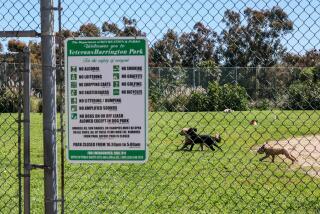Hawthorne dog shooting: What police can learn from mail carriers
There are many disturbing questions raised by the dog shooting by Hawthorne police. The video of a police officer shooting the 80-pound Rottweiler, Max, as the dog’s owner was being arrested has gone viral online and prompted outrage far beyond the South Bay city. The second most heartbreaking part of this video -- after the injured dog rolls over, flinching from the shots -- is the sound of the bystanders screaming and crying out in horror as they watch.
The video shows five police cars blocking off a street and officers halfway down the block from Leon Rosby, who saunters back and forth as he videotapes the police action. He has his dog with him on a leash. His own car is parked at the end of the block near an intersection.
Why did Hawthorne police believe it necessary to arrest Rosby in the first place? If he was a threat to whatever police matter was being played out halfway down the block, it’s not apparent on the videotape; the police officers had to walk down the block to him. Knowing what’s about to happen, Rosby puts his dog in his car with the windows down, calmly turns around, places his hands behind his back and waits to be cuffed.
After that, the dog, no doubt upset at seeing his owner taken away, barks, jumps out of the car and heads for his owner and the officers standing on the corner. Although the barking dog does confront the officers, the dog does not lunge at that point. Why didn’t the three officers all back away from the dog? They were not cornered. Behind them was plenty of street and at least one police car parked with a wide-open door. Instead, one officer reaches down toward the dog — or perhaps the leash — the dog lunges toward an officer, and then it is shot several times. Even after the dog lunged at one officer, there were two other officers there. Couldn’t they have subdued the dog, possibly with a baton?
It’s evident from the video that a fairly calm situation dramatically escalated into a tense and confusing one within seconds. And no one expects a police officer whose life is threatened by a dog to not disable or kill the dog. But just as we expect police officers to have skills and training to deal with tense situations involving people, we should expect them to be trained to deal with threatening situations involving dogs.
The Los Angeles Police Department -- a completely different agency from the Hawthorne force -- trains officers to try to mitigate situations with dogs before they get out of hand. Because dogs are so territorial, officers serving search warrants at homes carry small fire extinguishers that they can spray at a threatening dog. The big noise and burst of white powder usually make a dog back off.
Even friendly dogs often get up close to someone and bark. LAPD officers are advised to back up a bit and put their batons between themselves and a dog.
Mail carriers routinely deal with the threat of territorial dogs, and they do it without guns. They carry a pepper-based repellent spray, and, whenever they are outside their vehicles, they carry a satchel that can be put between themselves and an attacking dog.
Of course, there will be situations in which a police officer thinks force is necessary on a dog. Last year, there were 23 incidents of Los Angeles police officers firing their weapons at animals, according to an LAPD spokesman. (It’s unclear how often they actually injured an animal.) In comparison, there were 29 officer-involved shootings of people last year.
Police officers should be trained to employ a variety of approaches to dealing with a dog, including simply retreating. The tragedy of the Hawthorne situation is that there were probably a number of things the officers could have done differently so it never got to the moment of a lunging dog.
At the very least, the Hawthorne Police Department -- and other departments that may consider this a cautionary tale -- should offer better training for officers who find themselves confronted by dogs.
ALSO:
America’s first conservatives
Egypt’s rough road to democracy
More to Read
A cure for the common opinion
Get thought-provoking perspectives with our weekly newsletter.
You may occasionally receive promotional content from the Los Angeles Times.











